#plant profiles
Text

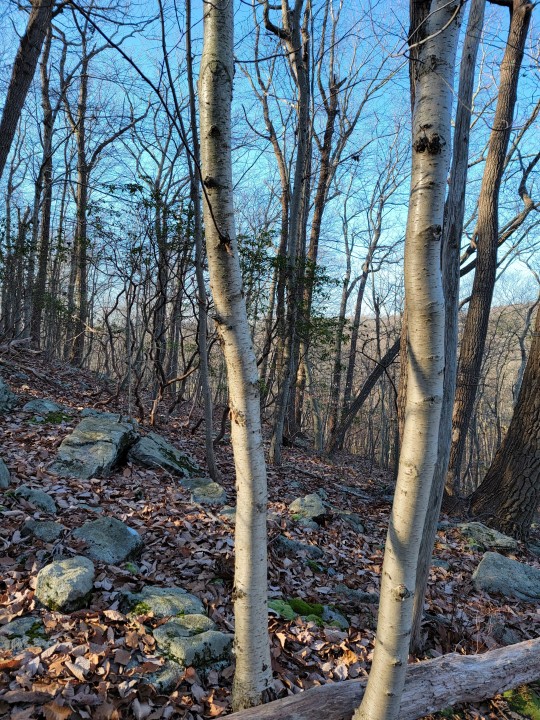
Quaking Aspen - Populus tremuloides
Today I want to bring up a charismatic favorite: the Quaking Aspen. Like all populus species, it's a fast growing, clonal colony forming, northern extreme and mountain loving tree (just like its Eurasian sister species: A. tremula) with an incredibly wide range of distribution. In addition to all those interesting qualities, the oldest known organism is presumed to be a Quaking Aspen colony (Pando, in Utah)
General identification before I can talk about the more interesting bits, Aspens are best known for their yellow autumn leaves and smooth white bark with dark knots, they can grow as large as 60' but depending on their environment can be stunted to around 5-20' (think of krummholz). Leaves of this species appear slightly heart shaped and retain the same sheen on both sides (image 1). Plants are unisexual meaning individuals either have male or female flowers, interestingly enough this is a good method to distinguish where one colony begins and ends by looking at the color of the branches in spring (see image from Colorado below, note trees with light green and those without). Emerging catkins are white at first which become green and longer as the season changes, male catkins having slightly longer stamen but female fruiting catkins ultimately growing longest at 10 cm. Seeds are small capsules with silky hairs to assist in wind dispersion, these trees are ruderal so they produce around 1.6 Million a season with many unable to germinate. Seedlings often need consistent moisture and full sun to even germinate, most of the seeds growth goes to root structure the first year.

The name Quaking Aspen (or trembling per the Latin) refers to the extremely mobile habit of the leaf. Leaves are connected to flexible petioles (stems) which flip around in the slightest breeze. Environmentally speaking, I was once told that leaves have chlorophyll on both sides however this stem could also be a biological strategy to cope with harsh wind conditions in mountainous environments, I didn't encounter any recent research verifying this though. Interestingly enough, given the harsh nature of which this tree thrives, apparently, there is chlorophyll in its trunk, allowing extra energy to enter the tree when it's leaves are gone.
Quaking Aspen is an early succession species, able to reestablish/colonize a site after a fire or other major disturbance. Many of Upstate New York's famous Aspen forests are actually a result of logging and fires in the early 1900s rather than a typical forest compostion. Establishment is different depending on opportunity, in the west its often long lived clonal roots systems, in the high arctic its often through wind blown seed, in the east its generally short lived clones out-competed by hardwood/conifer forest after a century, and in its furthest southeastern range I typically only encounter individuals on rocky outcrops or former fields.

Above ground trees usually live less than a century, in the east maybe 50-80 years given our moisture, out west individual trunks can live two centuries. It's common to find dense forests with even-age trees since clonal root structures re-emerge together (Image above from Bluebell Knoll Mountain in Utah). Its also thought that the root system can live for two millenia or longer, Pando being an example of extreme longevity (I mean 40,000 years would survive an ice age, even in Utah there would be mountain glaciation, thats quite spectacular if true). Ironically, one of the best survival tools in the Aspen's playback is fire recovery, otherwise it will get out-competed/shaded pretty fast (see the context in image 2, that NJ forest used to have lots of aspen).
All this in mind its good to point out that Aspen's early successional habit makes it great for ecological restoration. It's common to find them as the first pioneers on former mines or superfund sites (aspen grove below from Palmerton gap, Pennsylvania). Unfortunately one of the negative side affects is that populus species often bring up a lot of heavy metals in their leaves and wood meaning they can re-contaminate through their own biological accumulation. Which is good for extracting small scale contaiminants...very bad for large sites where you need to trap metal under soil to prevent toxins from eroding offsite
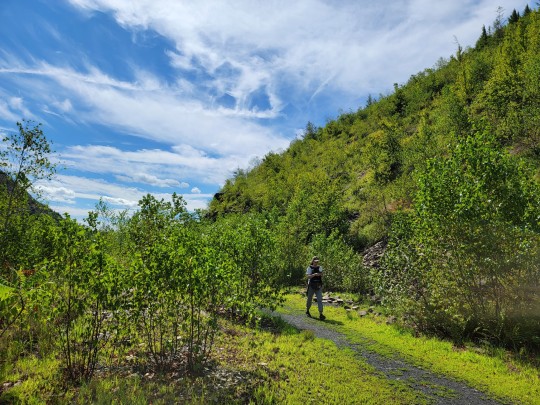
All this being said Quaking Aspen's large geographic range mirrors that of the last glacial maximum, implying a rapid spread onto retreating glaciers. This also suggests a growth habit requiring wet or moist soil conditions. This range is North West to Alaska nearly touching the Arctic Ocean at its Northern-most range in the Yukon, then east to Newfoundland; south west to Mexico (usually restricted to high mountains) and east from Iowa to New Jersey (with scattered populations in West Virginia).
Since Aspen often colonizes sites of former glaciation, with climate change it's predicted there will be a northward and uphill progression of populations. Aspen isn't really in intense danger of dissappearing but studies have shown major stressors (draught, extreme heat, over-grazing) cause higher mass-mortality events from minor stressors (typically disease and insect herbivorey). Given the fact that many forests are clonal there was a question of low genetic diversity amoung populations, yet interestingly, individuals undergo somatic mutations (DNA alterations after conception) and are extremely variable, so different individuals often place different energies into different defense tactics.
In addition to all of this information Aspens are primarily used today to make paper pulp. Historically settlers used aspen to derive quinine (think gin and tonic), and indigenous tribes have a history of using big trunks to create dug out canoes.
So please go out to your nearest mountain/boreal forest to enjoy the Quaking Aspen's lovely smooth bark and haunting shaking in the wind!
35 notes
·
View notes
Text

Golden Beginning 🌼🌾☀️
i originally drew this at the beginning of this year as a sort of new years piece looking forward to TotK release (hence the bnuuy shield since 2023 is year of bun)
#zelda#tears of the kingdom#zelda tears of the kingdom#TotK#Zelda TotK#link#zelda fanart#legend of zelda#daeyumi art#TotK art#TotK fanart#tears of the kingdom fanart#sky islands#i love Link sm i stg#ALSO sharp eyed viewers will notice that this is the piece i’m currently using as my profile pic across all platforms lol#i rly still think this is the only piece where i truly nailed the color for the golden plants on the sky islands
507 notes
·
View notes
Text

todays warmup… plant scar is. hnnrnngnhhh. everyone say thank u stiff
#i cannot capture the spirit of mullet plant hair so. erm. twiddles fingers. get giant ponytail instead.#thellos art corner#hes literally the most beautiful man ive ever seen. and also my wife#gtws ur side profile is my favourite thing to draw <333333#gtws fanart#goodtimeswithscar fanart#hermitcraft#mcyt#hermitcraft fanart#mcyt fanart
278 notes
·
View notes
Text

This is Larix laricina, commonly known as tamarack, hackmatack, and Eastern, red, black or American larch.
L. laricina is native to boreal and eastern temperate North America (Nature Serve), persisting right up to the northern treeline. It frequently grows in or at the edges of wetlands (swamps, fens, marshes, and riparian areas), but can tolerate a wide range of substrates and moisture. For a good overview of the species, check out this link.
It's one of those plants that can be a lightbulb moment for some people, inspiring them to reconsider basic assumptions about the way we divide up the natural world. When we learn about trees, many of us learn that there's two basic "types": deciduous trees and conifer trees. We are often told that deciduous trees are broad leaved and lose their leaves in the fall and that trees with needles don't.
Tamarack 'breaks' that; it is a deciduous conifer. Rightly, the language we are taught should be that there are deciduous and evergreen trees, that there are conifers and broad-leaf trees, and these categories can mix and match. (Of course, the trees haven't read the rules, so I wouldn't be the least bit surprised to find out there is a broadleaf coniferous gymnosperm--exceptions ARE the rule in ecology!)
#i could go on about this tree but i think the post would get too long#theyre a very cool boreal species!!!#tamarack#larix laricina#plants#ecology#nature#I think it's fitting for the first day's plant to be the one in my profile pic!
305 notes
·
View notes
Text

Jimmy Page, Robert Plant and manager Peter Grant in Vienna, March 16, 1973.
#seems like they're talking to bonzo but idk#also jimmy's side profile is everything 🥲#led zeppelin#jimmy page#robert plant#peter grant#classic rock#rock#hard rock#70s#1970s#by dee dee
207 notes
·
View notes
Text

"The little weed..."
it was a different idea, but it got too detailed and the original idea is more silly than this, so i turned what was already done into a piece of its own
(alternative backgrounds:)


#anfey care#art#digital art#artists on tumblr#flowey#flowey undertale#flowey fan club#undertale#undertale fandom#fanart#drawing#painting#illustration#artwork#icons#profile picture#flower#plant#that little weed... [/silly]
26 notes
·
View notes
Text
Been Wanting to Try this out with Bitty Argos for awhile Now :)

#Twomrp#Argos#Mr. Plant#I personally Regret Drawing Mr. Plant like this now- (Idk it's just the Side Profile yk)#Just look at them they're soo Cutee!#(Edited the Pic btw-)
60 notes
·
View notes
Text
My human stolitz is taking abit due to concerts and finals being very soon
So here's some eye love you matching pfps I made for me and my boyfriend's discord profiles, feel free to use with credit!


I already had the little Argos sketch so I thought it'd be fun to do the same theme for Mr. Plant
He even has a matching Argos plush! :]
#twomp#twomrp#the world of mr plant#world of mr plant#argos#argos twomp#twomp argos#mr plant#mr plant twomp#twomp mr plant#art#artist#drawing#twomp fanart#fanartist#digital fanart#fanart#matching profile pictures#profile picture#profile icons#profile pic art#profile photo#argos x mr plant#mr plant x argos#plargos#eye love you#mr plant fanart#argos fanart#ashur gharavi
24 notes
·
View notes
Photo

Efeu by Alphonse Mucha (1901, Druckgrafik)
#Alphonse Mucha#mucha#efeu#ivy#woman#hair#hair accessories#leaf#allegory#portrait#young#plant#plant lover#art lover#art#painting#side profile#czech#printmaking#print#art nouveau
53 notes
·
View notes
Text



◌ 🪷❜ (ꈍᵕꈍ) ◌ ◯



◌ 🎍❜ (ꈍᵕꈍ) ◌ ◯
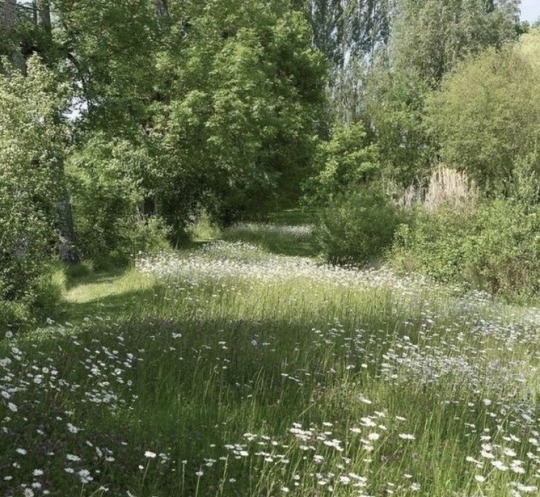


#kqrina#kpop mbs#aespa#kpop#kpop aesthetic#kpop girls#kpop selca icons#gg kpop#kpop decor#kpop profile#garden moodboard#garden#ive wonyoung#wonyoungism#wonyoung#new moodboard#ive moodboard#plant moodboard#sunny moodboard
21 notes
·
View notes
Text

Eva Watson-Schütze (1867-1935) :: Woman with Lily [Jane McCall Whitehead], 1905. Truth beauty: pictorialism and the photograph as art, 1845-1945 (George Eastman House, 2009) Phillips Collection
#eva watson schütze#eva watson schutze#pictorialism#early 1900s#1900s#smelling#smelling flower#the odor of lilies#profile#profil#pictorialist portrait#american pictorialism#potted plant#lily#lilies
226 notes
·
View notes
Text
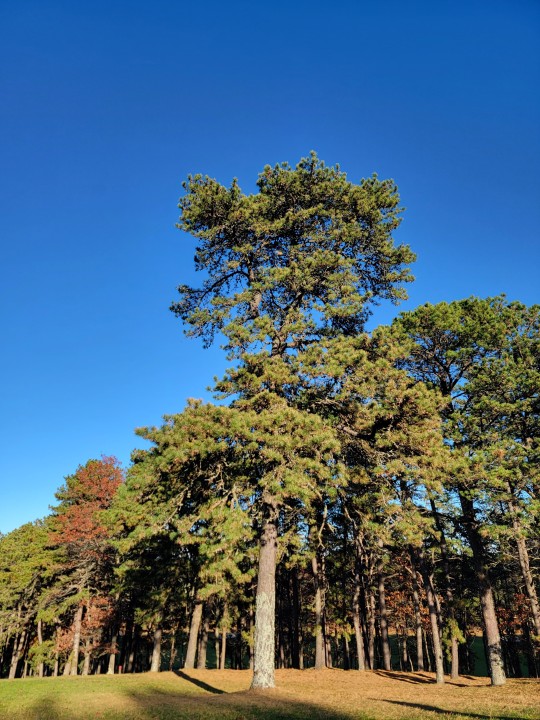
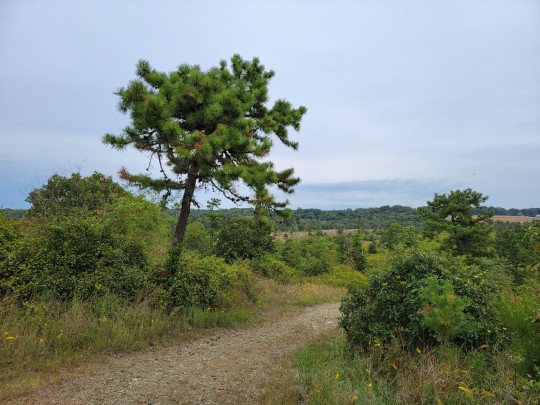

Pitch Pine - Pinus rigida
Today we have a resilient tree, one which grows in some of the harshest environments in the northeast, the Pitch Pine. This species of pine is well known as the most common tree in both the New Jersey and Long Island Pine Barrens. Growing in sandy, fire frequent, bare rock, and occasionally ultramafic conditions
Pitch Pine is a kind of extremophile, it excels where others cannot survive. The pine exists in fire ecologies and is adapted to these conditions: they retain cones up to 15 years on branches that open in the event of a fire, dormant buds protected underneath that thick bark can produce new leaves directly from the trunk quickly after major burns, and a very fast growth and reproductive maturity peroid.
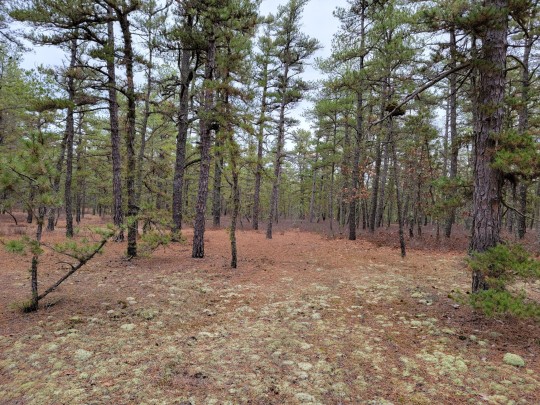
The Pitch Pine itself is generally scraggly in appearance and usually stops growing at around 60 feet with a maximum lifespan of maybe 200 years, after that it's usually out-competed by deciduous trees (this only happens with limited fire). Its bark is thick and heavily plated, its needles come in groups of three and are much more rigid than other pines. Cones are nearly circular and fresh ones are covered in spikes (very painful to handle!).
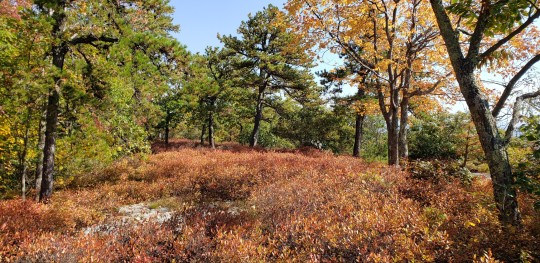
Distribution is from Maine to Georgia, only really growing in the Appalachias South of New Jersey. As for habitats I've seen this tree in the Virginia Blue Ridge, the seprentine barrens of Pennsylvania, everywhere in the pine barrens, dense south facing bare rock zones of the catskills (image above), and sporadically mixed in a forest in Maine. It's very common to find this species around blueberries, huckleberry, various oaks, Virginia pine, eastern white pines, and near atlantic white cedar swamps.
Onto usuage, the Pitch Pine gets its name for its resinous pitch saturated wood. Indigenous peoples (Iroquois Confederacy, Shinnecock, Lenape to name a few) wrote about utilizing the pitch to seal canoes, as a laxatives and to treat boils/burns. Settlers often saw this species as a decent waterproof lumber and a source of turpentine but mostly utilized pitch pine in long burns in large piles for charcoal production.

Pitch pine is a pretty great pioneer species within its range, My great grandfather discussed his attempt to keep the roads clear of these trees by his house only to destroy his chainsaw with the resinous pitch. He failed to actually keep the road clear and lost not only a few acres of Christmas tree farm (visible with a large pitch pine outgrowing some douglas fir above) but also an airport runway which a local wealthy family owned...50 years to this day I still haven't found the airport on maps or walking.
The only major danger to this species is from an introduced ambrosia beetle which has been killing large numbers throughout its range, but otherwise this species is not at risk.
So visit your local northeast mountaintop or barrens, the noise the wind makes when passing through pitch pine forests is hauntingly lovely, and keep an ear out for the subtle calls of the whipoorwhil as well.
11 notes
·
View notes
Text
oml i realised i didn't post this (I think)

#art#undertale#digital art#sans aus#undertale aus#digital#au sans#digital drawing#digital illustration#drawing#illustration#cypress#cypress sans#plant sans#plants#apple#profile
10 notes
·
View notes
Text

New profile pic!
I’ve had the same profile pic for years now, and I felt that we needed and upgrade.
I decided to up the saturation some, since I tended to use more desaturated colors before, and it kind of made everything look dull. I also added more nectar bubbles on my tail, as well as use colored line art instead of just black for everything.
8 notes
·
View notes
Text
i have a writing sideblog now & so many people just assume I'm a girl? I don't even have pronouns or anything in my bio but ppl keep calling me girl/sis/etc... :/
#but I did have a woman as my profile picture I guess that might have been it#bc I also tend to assume people are their profile picture. even if their profile picture is like a plant or something#so I have now changed my icon into an object instead of a person & we'll see if that helps 👍#doddie redet
6 notes
·
View notes
Text






some simple icons of my robot master designs so far.
#my art#mega man#mmfc#mega man fully charged#megaman#fc!gemini man#fc!snake man#fc!hard man#fc!metal man#fc!plant man#fc!crash man#icons#mmfc au#theres two or three more in the squad that i gotta design lol#MOSTLY did these for their wip toyhouse profiles
36 notes
·
View notes